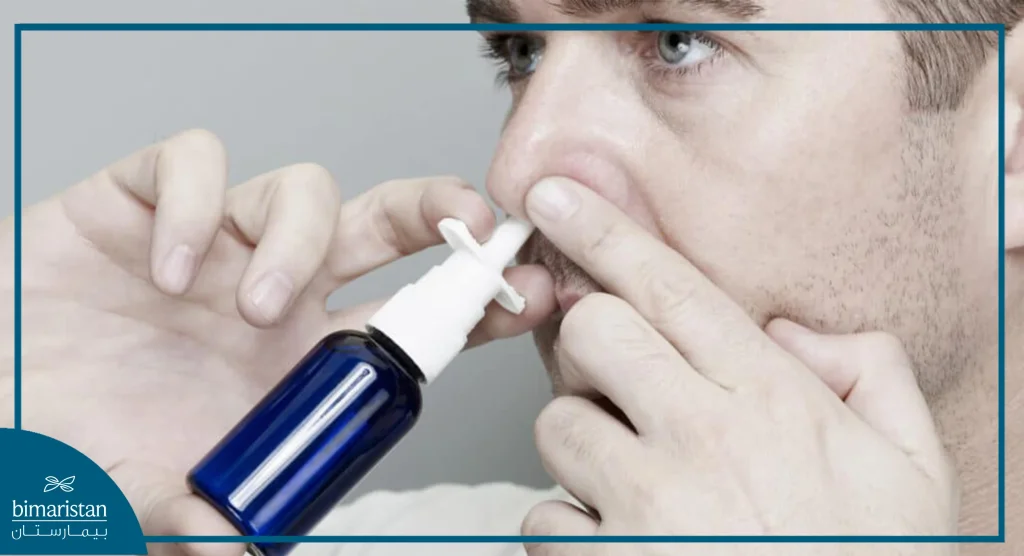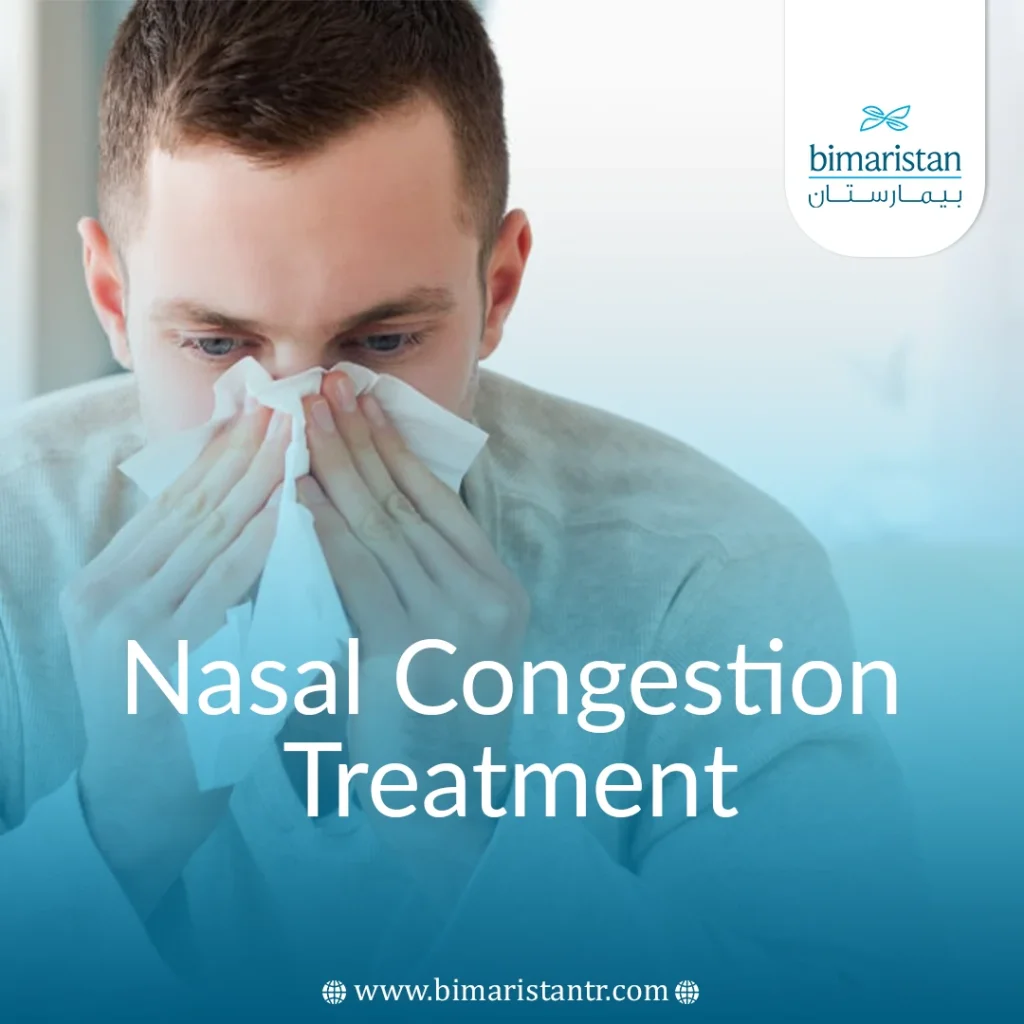Nasal congestion is a common issue that causes discomfort and symptoms like a runny nose and shortness of breath. Several nasal congestion treatment methods are available in Turkey.
Overview
Nasal congestion is defined as airflow obstruction through the nostrils due to swelling and congestion of blood vessels within the nose. This leads to increased secretion of mucus that accumulates and causes blockage and difficulty in airflow.
Nasal congestion is a common symptom of many diseases and medical conditions, and it is also frequently seen in children and adults.
Nasal congestion causes discomfort for those who suffer from it, and it may be accompanied by other symptoms such as runny nose, sneezing, snoring during sleep, and shortness of breath.
There are many reasons for nasal congestion, the most important of which are respiratory infections such as colds or influenza virus, sinusitis, or allergies to stimulants such as pollen.
Knowing the cause of nasal congestion is essential to developing an appropriate treatment plan, as treating the cause can eliminate congestion.
There are many ways to manage and treat nasal congestion, some of which are limited to applying nasal sprays that moisturize the nose and avoid drying it out or via steroid sprays that relieve congestion.
In rare cases, surgery is necessary if the congestion is accompanied by anatomical defects, polyps, or tumors.
Causes of nasal congestion
There are many causes of nasal blood vessel irritation and congestion, the most important and most common of which is a viral infection that affects the upper respiratory tract (such as a cold or flu).
There are other causes of nasal congestion, such as chronic sinusitis. Let’s review the most important causes of nasal congestion:
- Bacterial or viral infection (colds)
- Allergy to some stimuli (such as allergies to pollen or some animals)
- Sinusitis
- Deviated nasal septum
- Inhalation of a foreign body, especially in children
- Rhinitis medicamentosa (resulting from prolonged use of decongestants)
- Nasal vasculitis
- Pregnancy or asthma
Signs of nasal congestion
Nasal congestion is often a symptom of another disease, but in most cases, it is accompanied by the following symptoms:
- Rhinorrhea
- Mucus accumulation
- Sneezing
- Swelling of nasal tissues
Diagnosis of nasal congestion
The doctor diagnoses nasal congestion through symptoms and clinical exams. Nasal congestion treatment begins after examining the nose, ear, and throat to identify the cause.
The doctor examines the inside of the nose using a nasal endoscope, a flexible tube containing a light and a camera.
In some cases, the doctor may request a head CT scan to help assess the presence of a foreign body in the nose. A throat swab may also rule out diseases that cause nasal congestion, such as the novel coronavirus.
Nasal congestion treatment methods
Nasal congestion treatment can involve using saline drops or moisturizers to relieve dryness. In some cases, especially for children, a mucus suction device may prevent congestion and blockage.
It is best to consult your doctor before starting to treat nasal congestion with medication, as some medications used in treatment may have side effects if used for a long time.
Nasal congestion treatment methods are classified as follows:
Home remedies
Many home remedies are available to get rid of the annoying feeling of nasal congestion, and natural herbal treatment is also useful in removing nasal congestion and relieving symptoms of congestion.
If you feel that your nose is blocked or dry, try to keep the nasal passages and sinuses as moist as possible, either by using humidifiers or by frequent spraying.
Taking a long shower and inhaling steam from hot water helps prevent dryness in the nose. In addition, drinking large amounts of fluids helps soften nasal mucus, which helps prevent sinus congestion.
Placing a damp towel on the face also helps open the nasal passages.
Elevating the head with two pillows can ease breathing and aid in nasal congestion treatment during sleep. Additionally, using a device that emits vibration waves on the face can provide comfort.
In addition to the above, there are many natural treatment options, such as herbal treatment. Nasal congestion can be treated at home by taking homemade mixtures containing apple cider vinegar, which plays a good role as a nasal decongestant.
You can prepare an apple cider vinegar mixture by mixing it with honey in warm water and drinking the result.
Studies indicate that inhaling garlic is not an effective nasal congestion treatment and may actually worsen the condition, contrary to popular belief.
Medication treatment
Many medications work as nasal decongestants, including:
Decongestants: Decongestants work to reduce swelling of the nasal passages and reduce congestion. These medications are given in the form of nasal sprays such as naphazoline and oxymetazoline and may be given in the form of oral tablets such as phenylephrine.
Antihistamines: The primary indication for antihistamines is if nasal congestion is caused by an allergic problem. Antihistamines work to relieve allergic symptoms such as runny nose and sneezing.
Antihistamines can be combined with decongestants to reduce congestion and manage allergy symptoms.
Steroidal anti-inflammatory drugs: These come in the form of sprays and work to relieve congestion resulting from allergies. An example is fluticasone spray.
Pain relievers: They relieve pain and discomfort resulting from nasal congestion, but they do not solve the congestion problem.

Surgical treatment
Surgical nasal congestion treatment is rarely needed and is typically recommended only when the congestion is due to anatomical issues like tumors, nasal polyps, or a deviated septum.
Nasal congestion treatment ranges from simple approaches like saline solutions to more advanced options, including surgical interventions for severe cases. Choosing the right method depends on the severity of the condition and the patient’s specific needs.
For any questions or personalized medical advice on nasal congestion treatment, please contact us at Bimaristan Medical Center.
Sources:
